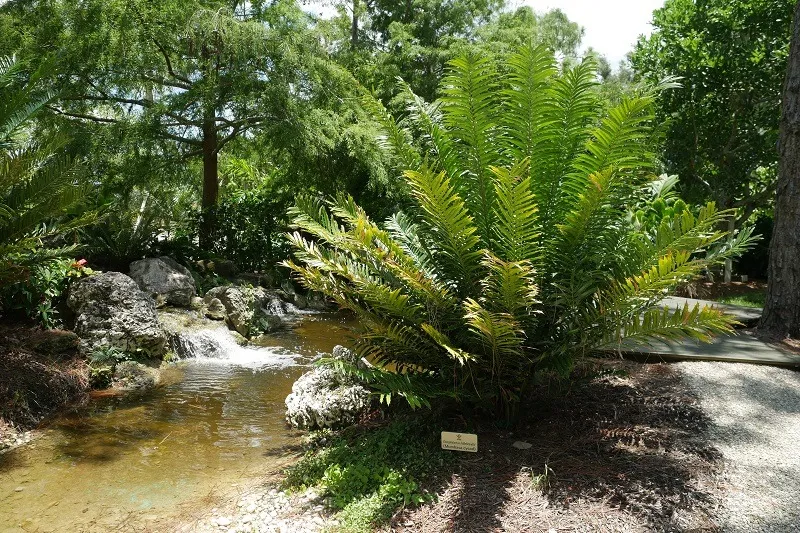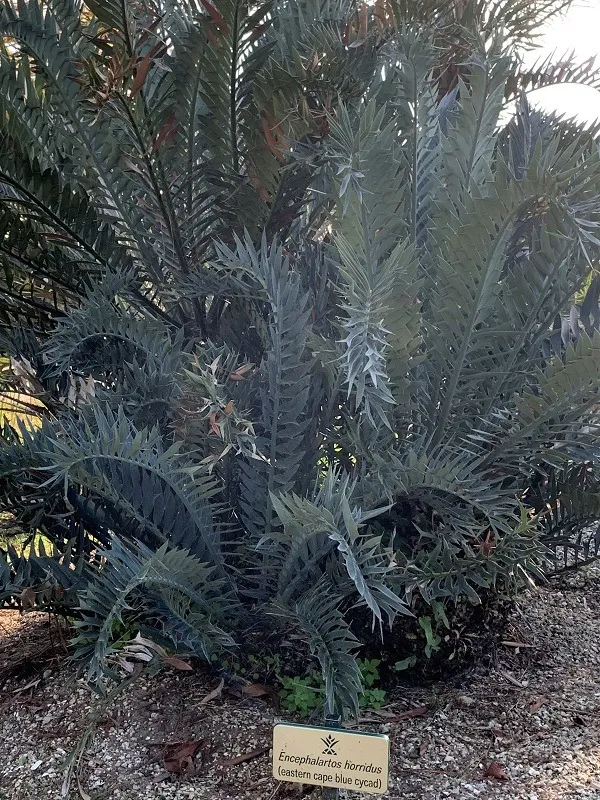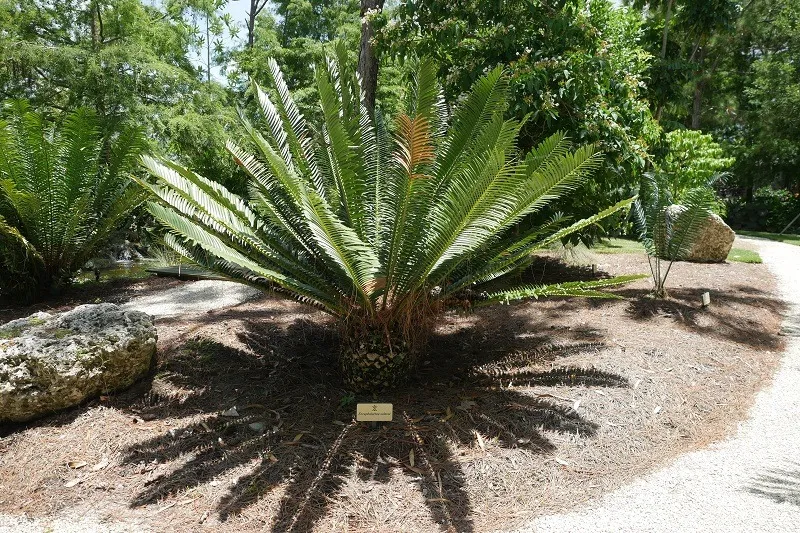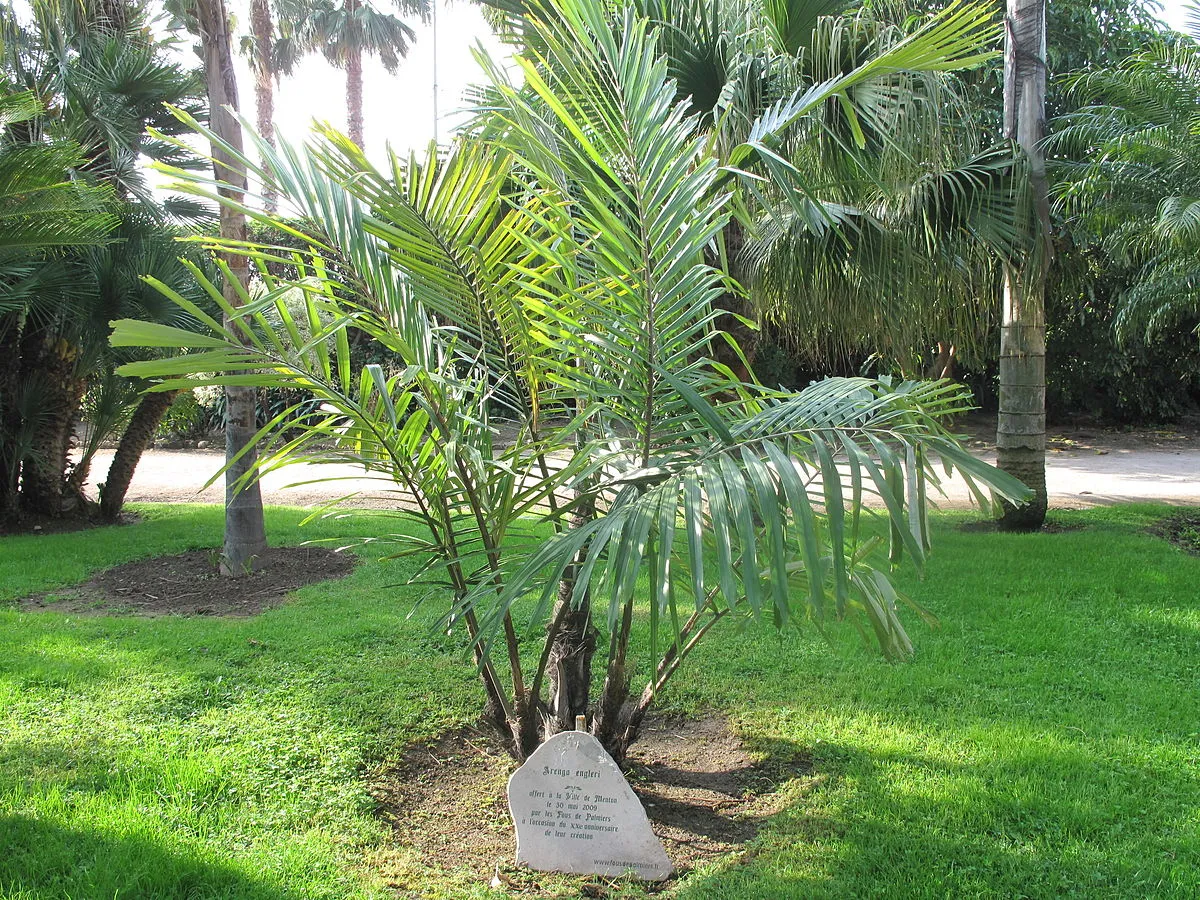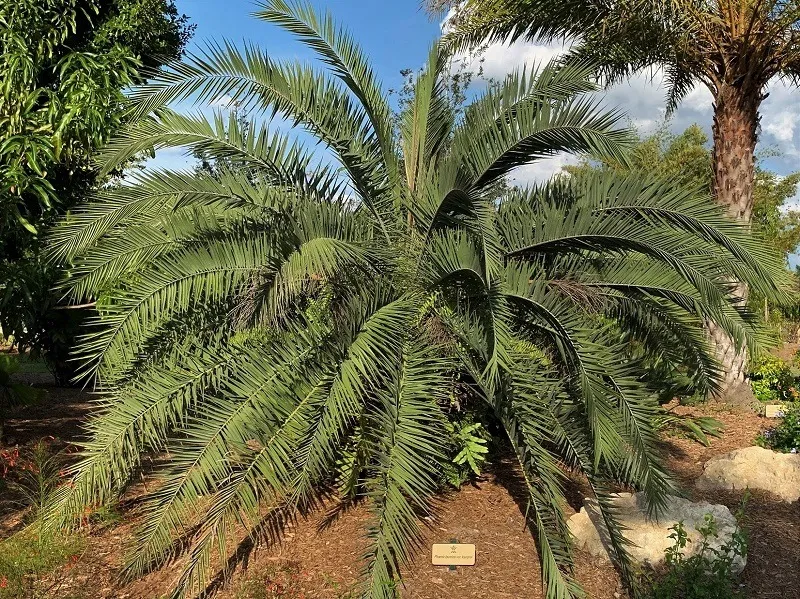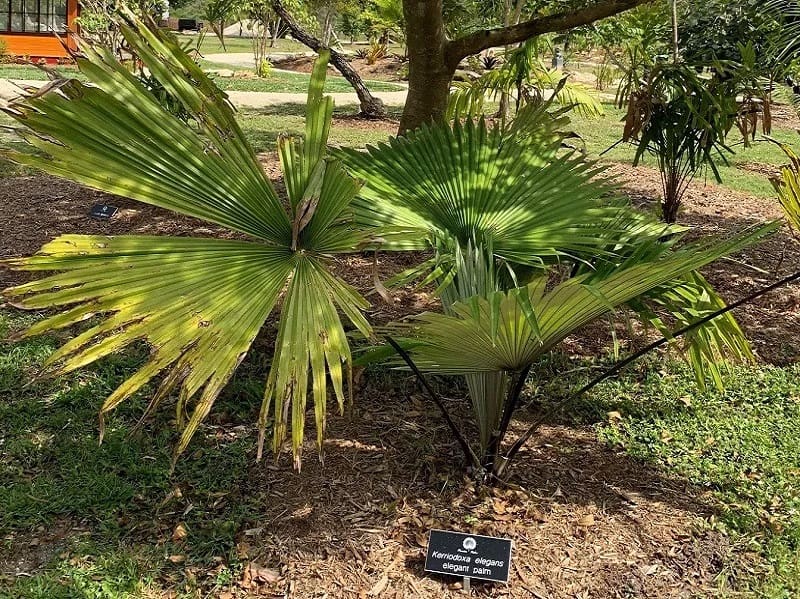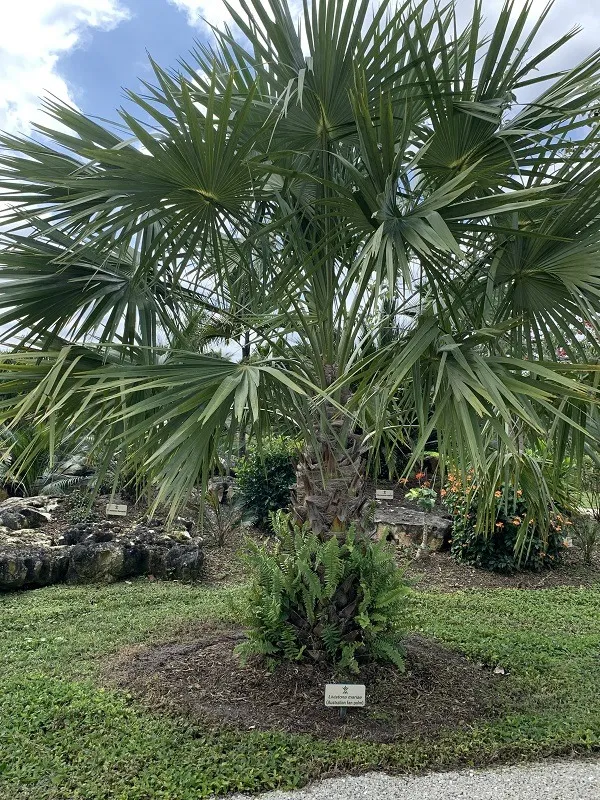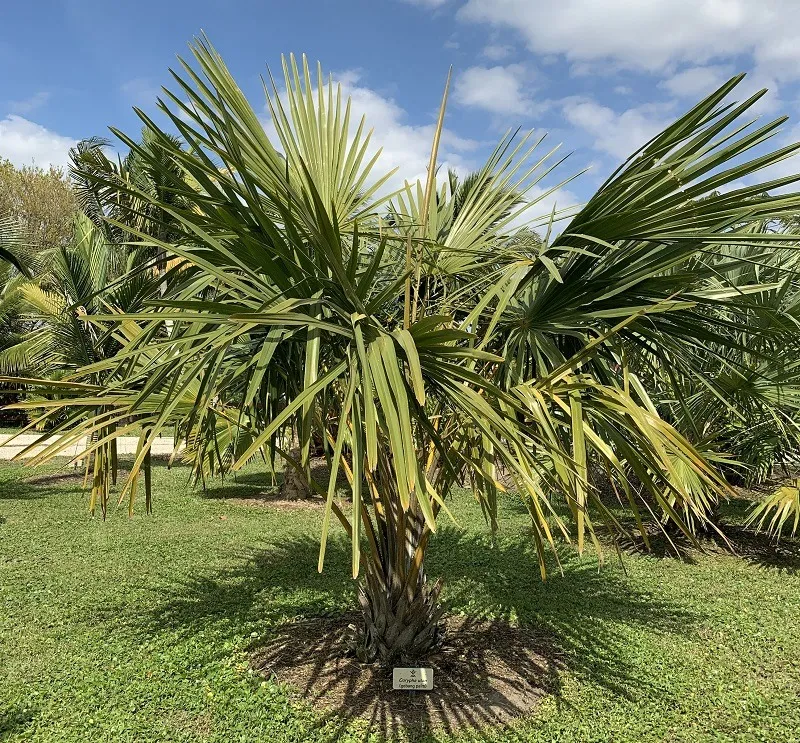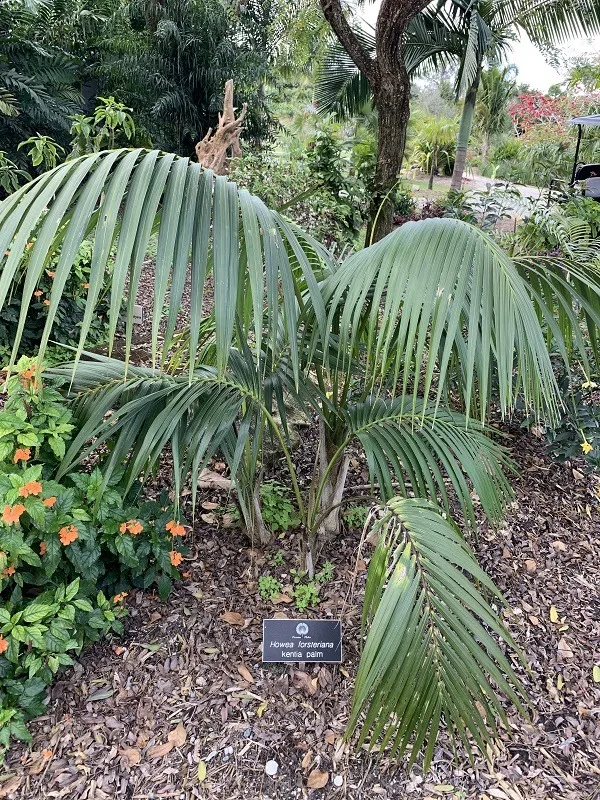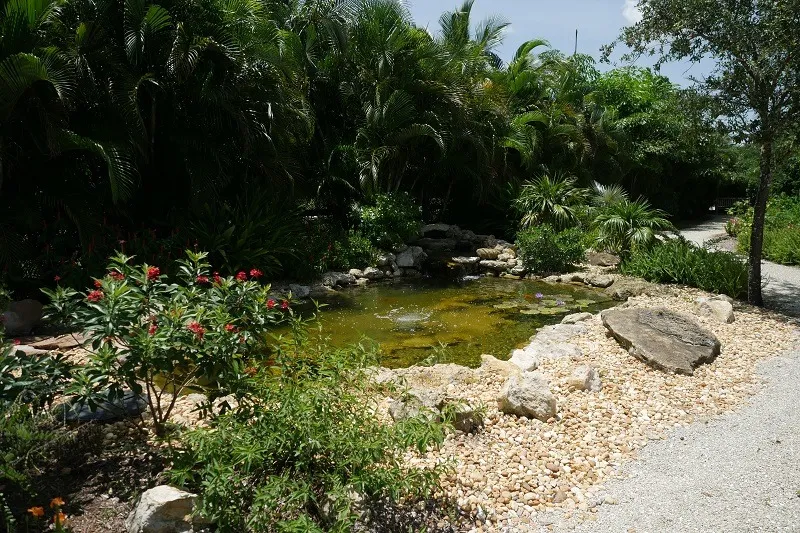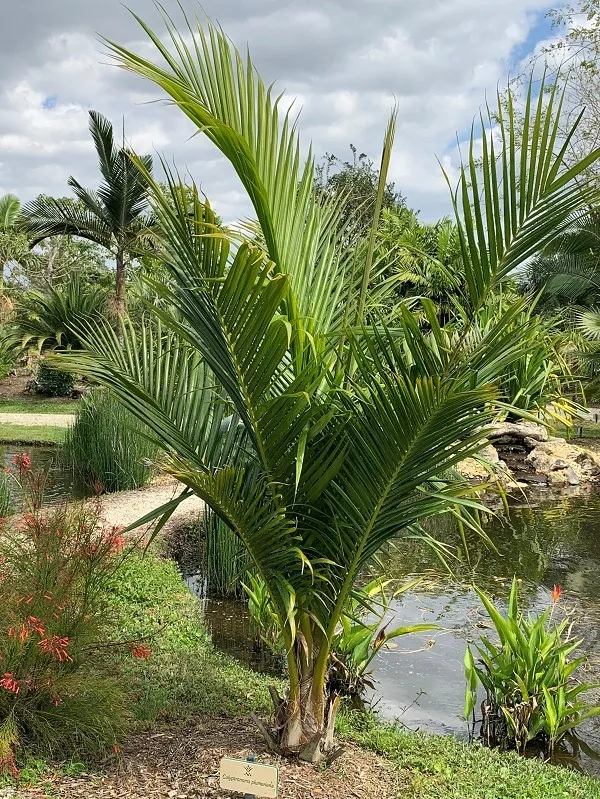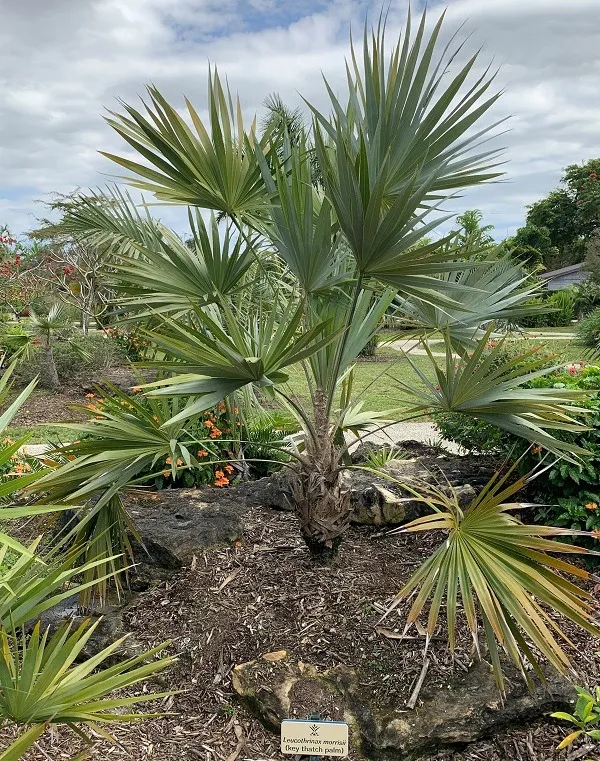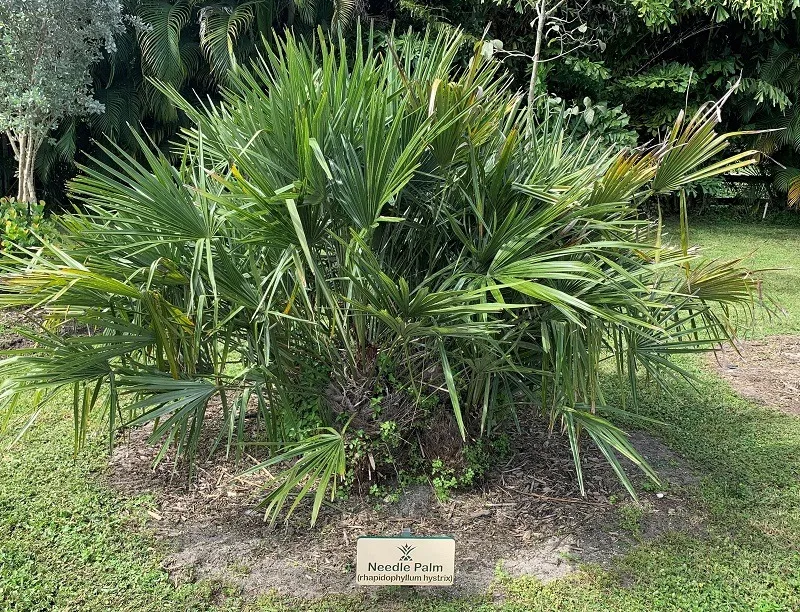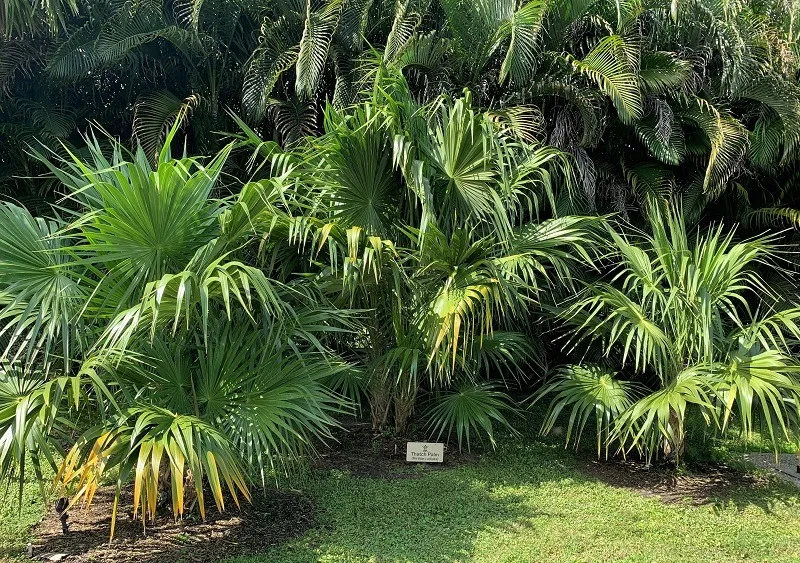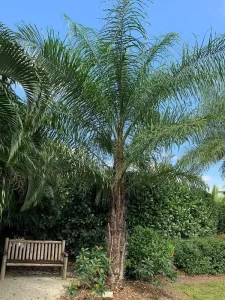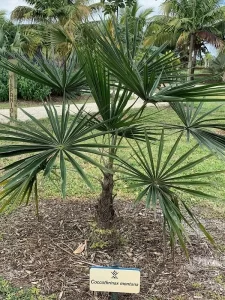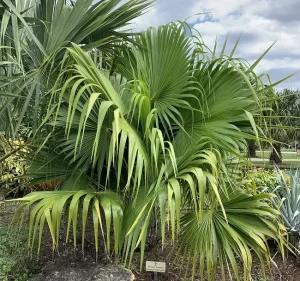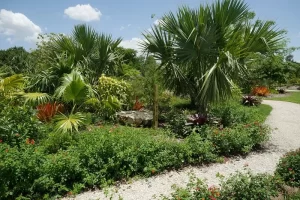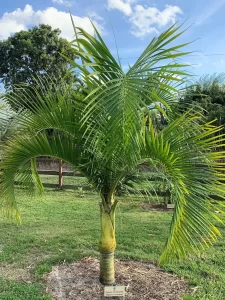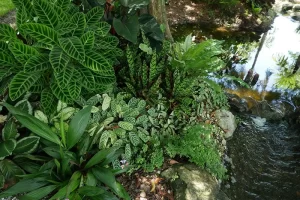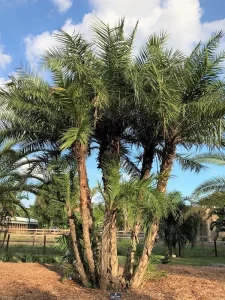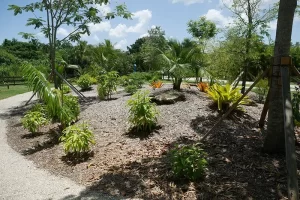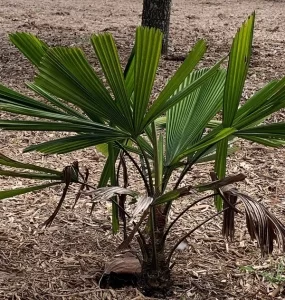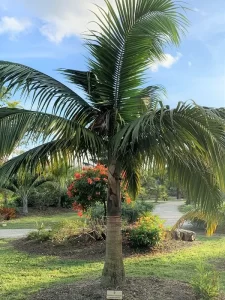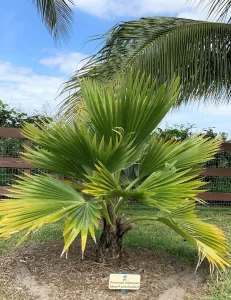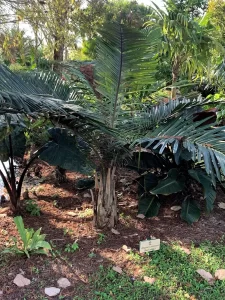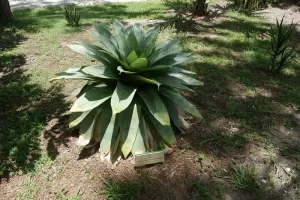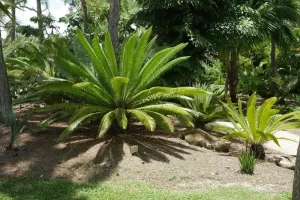African Cycad Section
Cycads, frequently mistaken for palms and even colloquially referred to as “sago palms,” diverge from this misconception as they belong to the botanical group of dicots. These remarkable plants stand as remnants from an ancient era, coexisting with the majestic dinosaurs that once roamed the Earth. Despite their misleading names, cycads are not true palms but rather belong to a unique lineage of plants that date back millions of years.
These intriguing flora, estimated to encompass over 400 different species, have sustained their existence across time, preserving a link to prehistoric ecosystems. Their presence predates numerous significant evolutionary events and environmental changes, offering a fascinating glimpse into the botanical history of our planet. Their resilient nature and adaptability have allowed them to endure and thrive, showcasing a remarkable diversity in form, size, and habitat.
As living relics from a bygone age, cycads play a vital role in botanical studies, offering insights into the ancient world and contributing to our understanding of evolutionary biology. Their distinctive characteristics, such as their cone-like structures and unique foliage, continue to capture the interest and curiosity of scientists and plant enthusiasts alike, underscoring their enduring significance in the living tapestry of Earth’s history.
Collection Includes
Encephalartos altensteinii ♦ Encephalartos arenarius ♦ Encephalartos cerinus ♦ Encephalartos concinnus ♦ Encephalartos dyerianus ♦ Encephalartos equatorialis ♦ Encephalartos ferox
Asia Section
This vast and diverse region, encompassing China, the majestic Himalayas, culturally rich India, tropical Indonesia, serene Japan, vibrant Malaysia, the historically significant Middle East, the scenic Philippines, lush Sumatra, captivating Taiwan, and the captivating landscapes of Turkey, stands as a botanical treasure trove. Within these lands lies an extraordinary collection of palm species, representing some of the oldest and most varied on the planet.
The sheer expanse of this region plays host to an astounding array of palm varieties, each exhibiting unique adaptations and ecological significance. From the soaring peaks of the Himalayas to the tropical paradises of Southeast Asia, the palms within these lands paint a stunning portrait of botanical diversity. Their presence not only shapes the local landscapes but also holds great historical, cultural, and economic importance for the communities residing in these areas.
India, as a prime example, boasts a rich tapestry of palms with a remarkable count of over 105 distinct species. These palms are not only integral to the country’s ecosystems but also deeply interwoven into its cultural fabric. They provide resources for sustenance, traditional practices, and are revered for their aesthetic value.
The sheer number and diversity of palm species across these lands exemplify the resilience and adaptability of these plants to varied climates and terrains. Their significance goes beyond their botanical richness, offering invaluable resources, shaping landscapes, and contributing to the cultural heritage of the regions they inhabit. This bountiful region serves as a testament to the significance and splendor of palm diversity and its profound impact on the multifaceted tapestry of life within these diverse and culturally rich landscapes.
Collection Includes
Areca ♦ Arenga ♦ Bentinckia ♦ Borassodendron ♦ Borassus ♦ Caryota ♦ Chuniophoenix ♦ Cocos ♦ Corypha ♦ Cyrtostachys ♦ Heterospathe ♦ Iguanura ♦ Kerriodoxa ♦ Lanonia ♦ Licuala ♦ Livistona ♦ Loxociccus ♦ Metroxylon ♦ Oncosperma ♦ Orania ♦ Phoenix ♦ Pinanga ♦ Rhapis ♦ Rhopaloblaste ♦ Saribus ♦ Trachycarpus ♦ Wallichia
Australia Section
Palms and cycads showcase an extraordinary level of adaptability, a trait that’s particularly evident in their survival mechanisms within Australia’s diverse landscapes. In the tropical and subtropical coastal regions of Australia, these resilient plants have evolved and adapted to withstand the challenging and dynamic environmental conditions prevalent in these areas.
With an innate ability to weather frequent natural disturbances, certain palm and cycad species in these regions have developed remarkable adaptations. These plants have honed their resilience to endure the ferocity of periodic hurricanes, which can unleash devastating winds and rain. Over time, they have evolved structural features that allow them to flex and bend without succumbing to the destructive forces of these powerful storms.
Moreover, these plants have also acclimated to survive in the face of recurrent wildfires, a natural phenomenon in the Australian landscape. Their fire-resistant characteristics, such as specialized protective coatings, thick bark, or self-sealing properties, equip them to withstand and recover from the intense heat and flames. Some species have even evolved mechanisms to resprout or regenerate rapidly after fire, ensuring their survival in this fire-prone environment.
The capacity of these palms and cycads to not only endure but thrive in such extreme conditions is a testament to their resilience and adaptability. Their ability to persist and even thrive in the face of these formidable natural challenges highlights the intricate and awe-inspiring ways in which plants evolve to navigate and survive within the ever-changing and often harsh environments they call home.
Collection Includes
Archontophoenix ♦ Arenga ♦ Calamus ♦ Carpentaria ♦ Corypha ♦ Howea ♦ Licuala ♦ Livistona ♦ Normanbya ♦ Oraniopsis ♦ Ptychosperma ♦ Wodyetia ♦ Bowenia ♦ Lepidozamia ♦ Macrozamia
Cuba Section
The island of Cuba, an ecological treasure trove, harbors a diverse array of captivating palms and cycads, among which stands the remarkable “cork palm.” This species, believed to have established its roots on the island for over 100 million years, offers a captivating glimpse into the enduring botanical history of this region.
The cork palm, scientifically significant and intriguing, serves as a living relic from a bygone era, providing scientists with a window into the ancient past. Its existence for such an extensive period suggests an incredible continuity and adaptation within Cuba’s unique ecological landscape. Endemic to the island, this palm has evolved and thrived, demonstrating an extraordinary level of resilience and adaptability that has enabled it to survive numerous climatic and environmental changes over the millennia.
This ancient palm’s presence echoes the longstanding evolutionary journey of flora in the Caribbean, standing as a living testament to the island’s ecological heritage. Its longevity and persistence amidst shifting ecological dynamics signify a testament to the species’ ability to withstand the test of time.
Scientific interest in the cork palm extends beyond its historical significance. Researchers study its genetic makeup, morphology, and ecological interactions, aiming to uncover insights into its adaptations and survival strategies. Understanding the evolutionary trajectory of this enduring species contributes to our broader comprehension of plant evolution, climate history, and the intricate interplay between flora and the environment.
The discovery and preservation of the cork palm on Cuba underscore the importance of safeguarding and studying these botanical treasures. As an integral part of Cuba’s natural heritage, this ancient species stands as a symbol of endurance and resilience, weaving a narrative that links the island’s botanical past to its vibrant present.
Collection Includes
Acoelorrhaphe ♦ Acrocomia ♦ Calyptronoma ♦ Coccothrinax ♦ Colpothrinax ♦ Copernicia ♦ Gaussia ♦ Hemithrinax ♦ Leucothrinax ♦ Prestoea ♦ Pseudophoenix ♦ Roystonea ♦ Sabal ♦ Thrinax ♦ Microcycas ♦ Zamia
Florida Section
Florida’s subtropical climate, characterized by its unique blend of hot, wet summers and cool, dry winters, creates an ideal haven for a wide array of palms and cycads, both indigenous to the region and originating from other parts of the world. The diverse and hospitable climate of Florida plays a pivotal role in nurturing these botanical wonders, enabling them to flourish in this dynamic environment.
The subtropical climate of Florida offers a balance of seasonal changes that these plants find favorable. The hot and wet summers provide an abundance of moisture and warmth, creating optimal conditions for growth and reproduction. This environment allows palms and cycads to thrive, fostering lush greenery and vibrant foliage.
Conversely, the cool and relatively dry winters in Florida offer a reprieve from the intense heat, providing a period of rest for these plants. This season allows for necessary dormancy and regeneration, enabling them to conserve energy and prepare for the subsequent growth spurt during the following summer. This cyclical pattern of distinct seasons forms a natural rhythm that these botanical species have adapted to over time.
Moreover, Florida’s welcoming climate not only supports the native palms and cycads but also acts as a sanctuary for species from various regions around the globe. This diversity enriches the botanical landscape, creating a melting pot of palm and cycad varieties, each contributing its unique characteristics to the region’s biodiversity.
The ability of these plants to not just survive but thrive in Florida’s climatic conditions showcases their remarkable adaptability and resilience. Their success in this environment underscores the importance of understanding and preserving the delicate balance that sustains the growth and vitality of these botanical treasures within the vibrant ecosystem of Florida.
Collection Includes
Acoelorrhaphe ♦ Coccothrinax ♦ Leucothrinax ♦ Pseudophoenix ♦ Rhapidophyllum ♦ Roystonea ♦ Sabal ♦ Serenoa ♦ Thrinax ♦ Zamia
Hispaniola Section
The Caribbean island of Hispaniola, comprising both the Dominican Republic and Haiti, stands as a botanical paradise, hosting an astounding diversity of over 35 distinct palm species. What makes this island particularly remarkable is that 23 of these palm species are endemic, exclusively calling Hispaniola their home and not found in any other part of the world.
This exceptional concentration of unique palm species on Hispaniola underscores the island’s significance as a hotspot of biodiversity, making it a treasure trove for plant enthusiasts and researchers alike. These endemic palms have evolved and adapted over time to the island’s specific ecological niches, weather patterns, and diverse terrains, leading to their exclusivity to this region.
The presence of these unique palm species serves as a testament to the geological and ecological history of Hispaniola. Their isolation on the island has fostered distinct genetic variations, creating a botanical heritage that is unparalleled. Studying these endemic palms not only offers insights into their evolutionary processes but also provides valuable information about the island’s environmental changes and biological interactions over time.
Moreover, the preservation of these endemic palm species on Hispaniola becomes imperative for conservation efforts. As these plants exist nowhere else on Earth, safeguarding their habitats and promoting their well-being is essential for maintaining the island’s biodiversity and preserving these unique biological treasures for future generations.
The extraordinary diversity and exclusivity of these palms on Hispaniola not only enrich the island’s natural beauty but also offer a rich tapestry for scientific research, fostering a deeper understanding of plant evolution and the intricate connections between flora and the environment. Their presence stands as a testament to the island’s ecological heritage and highlights the significance of preserving and protecting these invaluable botanical assets.
Collection Includes
Acoelorrhaphe ♦ Coccothrinax ♦ Leucothrinax ♦ Pseudophoenix ♦ Rhapidophyllum ♦ Roystonea ♦ Sabal ♦ Serenoa ♦ Thrinax ♦ Zamia
Jamaica Section
Jamaica, despite sharing some landscape similarities with its neighboring islands of Cuba and Hispaniola, stands out for its somewhat distinct botanical diversity. While not as extensively diverse as these neighboring islands, Jamaica still hosts a rich variety of palms and cycads that thrive in its unique environmental niches.
The island’s geographical terrain, though reminiscent of the surrounding regions, displays a notable difference in plant diversity. Despite this variance, palms and cycads have found their niche and demonstrate a remarkable ability to flourish in Jamaica’s specific climate and landscapes.
The distribution of these botanical wonders is intriguing, with a few palm and cycad species finding their home in the island’s mountainous regions. However, the most captivating presence of these plants lies in clusters along the picturesque and inviting beaches of Jamaica. These coastal areas offer an optimal habitat for these plants due to the sandy soils, ample sunlight, and moderate exposure to coastal elements.
The presence of these botanical treasures along the beaches contributes to the island’s aesthetic appeal, offering a picturesque backdrop to its already stunning coastal vistas. The palms and cycads not only add to the scenic beauty but also play a vital ecological role in stabilizing coastal areas and contributing to the biodiversity of these ecosystems.
While Jamaica may not boast the same level of overall plant diversity as its neighbors, the successful adaptation and proliferation of palms and cycads in its specific ecological niches speak volumes about the resilience and adaptability of these plants. Their ability to thrive in Jamaica’s beach clusters showcases their capacity to carve out a space within diverse ecosystems, contributing to the island’s natural charm and ecological balance.
Collection Includes
Acoelorrhaphe ♦ Coccothrinax ♦ Leucothrinax ♦ Pseudophoenix ♦ Rhapidophyllum ♦ Roystonea ♦ Sabal ♦ Serenoa ♦ Thrinax ♦ Zamia
Madagascar and Africa Section
The African continent, renowned for its vast and diverse landscapes, is home to a remarkable assortment of 65 palm species. However, the nearby island of Madagascar, a relatively small landmass off the African coast, stands out as an exceptional hotspot of palm diversity. With an astonishing 204 species of palms, Madagascar boasts three times the number found on the entire African continent, highlighting its significance as a botanical treasure trove.
What makes Madagascar particularly remarkable is that an overwhelming 98% of its palm species are endemic, existing solely on this isolated island and not found anywhere else on Earth. This unparalleled level of endemism within the palm species on Madagascar underscores the island’s unique evolutionary history and distinct ecological characteristics.
The diverse range of palm species on Madagascar reflects the island’s varied ecosystems, from lush rainforests to arid regions. Each species has adapted to specific niches within this diverse landscape, showcasing a spectacular array of shapes, sizes, and adaptations. The palms play an integral role in Madagascar’s biodiversity, providing essential resources and contributing to the island’s rich and complex ecosystems.
The conservation of these endemic palms becomes crucial for the preservation of Madagascar’s unique natural heritage. Protecting these species and their habitats is essential to maintain the island’s biodiversity and prevent the loss of these exclusive botanical treasures. Moreover, these palms hold immense scientific value, offering insights into evolutionary processes and contributing to our understanding of plant diversity and adaptation.
The remarkable concentration and exclusivity of palm species on Madagascar serve as a reminder of the island’s ecological importance and underscore the urgency of preserving these invaluable biological assets for future generations. Their existence stands as a testament to the island’s environmental legacy and highlights the critical significance of safeguarding these extraordinary plants in the face of environmental challenges and human impact.
Collection Includes
Acrocomia ♦ Calyptronoma ♦ Sabal ♦ Thrinax ♦ Zamia
New Guinea Section
Spanning across the expanses of New Guinea, which stands as the largest tropical island globally, and encompassing the Bismarck Archipelago, Maluku Islands, and Caroline Islands, this region is a botanical marvel, hosting a stunning diversity of more than 250 palm species. This area is celebrated as an exciting and vibrant center for palm exploration, research, and conservation, offering an ever-unfolding narrative of biodiversity and discovery.
The sheer variety of palms found in this region showcases an astounding richness of plant life. The lush landscapes and diverse ecosystems provide ideal habitats for these palms, offering a myriad of ecological niches where these plants have evolved and adapted over time. From the rugged mountainous terrains to the vibrant coastal regions, each habitat harbors its unique palm species, contributing to the incredible diversity found here.
The continuous discovery of new palm species in this region underscores the untapped potential for exploration and research. Year after year, scientists and botanists unveil previously undiscovered species, adding to the already extensive list of palms found in this area. These ongoing discoveries fuel excitement and interest in understanding the evolution, ecology, and conservation of these fascinating plants.
Furthermore, the exploration and study of palms in this region play a crucial role in advancing scientific knowledge about plant diversity, evolution, and ecological dynamics. It offers an invaluable opportunity to comprehend the intricacies of these species, their relationships with their environment, and the conservation measures required to preserve their biodiversity.
The conservation efforts in this area are of paramount importance due to the rapid environmental changes and increasing human impact. Protecting the habitats of these diverse palm species is critical to maintain their genetic diversity and safeguard their existence for future generations.
This region, teeming with botanical wonders yet to be fully discovered and appreciated, stands as an exciting frontier for palm enthusiasts and researchers, offering a window into the incredible diversity and evolutionary adaptations of these plants. The continuous exploration, research, and conservation efforts in this area not only enrich our understanding of palms but also contribute significantly to the broader scientific understanding of biodiversity and ecosystem preservation.
Collection Includes
Acrocomia ♦ Aiphanes ♦ Allagoptera ♦ Asterogyne ♦ Astrocaryum ♦ Attalea ♦ Bactris ♦ Brahea ♦ Butia ♦ Butiagrus ♦ Calyptrogyne ♦ Chamaedorea ♦ Chelyocarpus ♦ Copernicia ♦ Cryosophila ♦ Elaeis ♦ Euterpe ♦ Gaussia ♦ Geonoma ♦ Iriartea ♦ Itaya ♦ Mauritia ♦ Phytelephas ♦ Reinhardtia ♦ Roystonea ♦ Sabal ♦ Sabinaria ♦ Schippia ♦ Syagrus ♦ TrithrinaxCeratozamia ♦ Dioon ♦ Zamia
South Pacific Section
The South Pacific, a vast and diverse region consisting of Polynesia, Melanesia, Micronesia, and a myriad of islands such as Hawaii, Tahiti, Easter Island, Fiji, Papua New Guinea, the Cook Islands, Samoa, Tonga, and Vanuatu, forms a tapestry of unique and varied ecosystems. This region boasts a rich diversity of palms, with the ubiquitous presence of the iconic coconut palm being a unifying botanical thread across these lands.
The coconut palm, a symbol of the tropics, thrives across every one of these islands, offering not only a source of food, shelter, and resources for the local populations but also serving as a testament to the interconnectedness of these diverse cultures and landscapes. Beyond the coconut palm, these islands are home to a collection of a dozen or more palm species introduced from outside the region. These imported species have established themselves within the South Pacific, adapting to the local environments and becoming an integral part of the unique ecosystems.
The palm diversity in the South Pacific mirrors the region’s cultural richness and historical connections. Palms hold significant cultural and economic importance across these islands, deeply intertwined with local traditions and livelihoods. They are utilized in various ways, from providing food and materials for construction to being woven into crafts and ceremonies, thus contributing to the fabric of these island societies.
The exchange of palm species between these islands and with other regions reflects the historical movements of people, trade, and colonial influences. The introduction of new species into the South Pacific has added to the botanical diversity and enhanced the ecological landscapes of these islands.
Understanding the dynamics of palm distribution and diversity in the South Pacific not only contributes to botanical knowledge but also sheds light on the historical and cultural interactions that have shaped these islands. Preserving and sustaining the palm diversity in this region is not only crucial for the conservation of the plant species but also for safeguarding the cultural heritage and ecological balance that these palms represent across the diverse landscapes of the South Pacific.
Collection Includes
Balaka microcarpa ♦ Burretiokentia hapala ♦ Carpoxylon macrosperma ♦ Chambeyronia macrocarpa ♦ Clinostigma samoensis ♦ Cyphophoenix elegans ♦ Cyphophoenix nucele ♦ Cyphosperma trichospadix
Americas Section
The expanse of North America, Central America, and South America encompasses a staggering array of plant species, mirroring the immense diversity of these continents. From the Arctic reaches to the southernmost tips, this vast region hosts an astonishing variety of ecosystems and landscapes, each providing a unique niche for a wide range of plant life, particularly palms and cycads.
Palms and cycads, emblematic of the region’s botanical richness, flourish abundantly across this vast expanse, thriving in diverse environments that range from deserts to mountain rainforests. Their adaptability to a broad spectrum of soil types and ecological settings showcases their resilience and versatility in the face of varied climates and terrains.
In the arid landscapes of deserts, palms and cycads demonstrate their remarkable ability to survive with limited water, adapting to harsh conditions by conserving moisture and withstanding high temperatures. Their presence in these challenging environments contributes to the ecological diversity and stability of these regions, showcasing their endurance amidst harsh climates.
Conversely, in the lush and biodiverse mountain rainforests, these plants carve out their existence, adding to the verdant tapestry of diverse flora. They play a vital role in these ecosystems, contributing to the structural and ecological integrity of these habitats while providing essential resources for the local wildlife.
Their ubiquity in such varied terrains across North, Central, and South America signifies their crucial ecological role and their status as indicators of the region’s biological richness. The presence of these plants in such diverse environments underscores their significance in preserving the health and equilibrium of these ecosystems, while also providing invaluable resources for local communities and contributing to the overall biodiversity of the region.
The continuous existence and adaptability of palms and cycads across these continents highlight their resilience and their integral role in shaping the diverse and multifaceted landscapes found in North America, Central America, and South America. Studying and conserving these plants is not only vital for understanding the ecological dynamics of these regions but is also crucial for preserving the intricate and rich biological heritage they represent.
Collection Includes
Acrocomia ♦ Aiphanes ♦ Allagoptera ♦ Asterogyne ♦ Astrocaryum ♦ Attalea ♦ Bactris ♦ Brahea ♦ Butia ♦ Butiagrus ♦ Calyptrogyne ♦ Chamaedorea ♦ Chelyocarpus ♦ Copernicia ♦ Cryosophila ♦ Elaeis ♦ Euterpe ♦ Gaussia ♦ Geonoma ♦ Iriartea ♦ Itaya ♦ Mauritia ♦ Phytelephas ♦ Reinhardtia ♦ Roystonea ♦ Sabal ♦ Sabinaria ♦ Schippia ♦ Syagrus ♦ Trithrinax ♦ Ceratozamia ♦ Dioon ♦ Zamia


